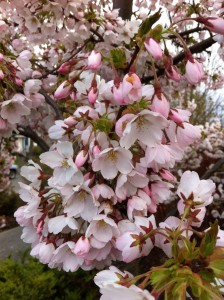Cherry blossoms in Seattle – great varieties for you to consider for your landscape
Posted on April 13th, 2012 by Andy

Photo by Ecoyards
It’s a sure sign of spring when you can spot the explosion of white and pale pink blossoms on cherry trees throughout the Northwest. There are no shortage of places to view cherry blossoms, which are in their prime from about late March into early April. The University of Washington’s Quad is one of the many places where you can walk under a canopy of pink and white blossoms. The 31 Yoshino cherry trees that line the campus quad start blooming in late March and go for about three weeks. According to the UW, the Washington Park Arboretum bought and planted these Yoshino cherry trees around 1939. In the early 1960s, they were brought to the UW campus when State Route 520 was built.
If you’re looking to plant ornamental cherry trees at your home, Yoshino cherry is one of the best bets for the Seattle area. Yoshino cherry, or prunus yedeoensis, is a Great Plant Pick, which means it is well-suited for growing in the Seattle area. Once established, the plant is drought tolerant. It’s also disease resistant and loves our cool, wet weather. The tree develops golden yellow and orange colors in the fall. It is originally from Japan and has been widely planted in the U.S., including in Washington, D.C. Great Plant Picks also recommends three other ornamental cherry tree varieties that do well in the Seattle area, including Akebono, Japanese Flowering Cherry and Cornelian Cherry.
The exchange of cherry trees between Japan and Washington, D.C., has a long and interesting history _ with a Seattle connection. In 1909, First Lady Helen Taft backed the idea of planting cherry trees in the nation’s capital, according to this National Park Service timeline. That year, Japan donated 2,000 trees to Washington to be planted along the Potomac River. The trees were shipped from Japan through Seattle on Dec. 10, 1909. When they arrived in D.C., agricultural inspectors discovered that they were infested with insects and nematodes, and President Taft agreed to have them burned to protect American growers. The NPS timeline shows that in 1912, Japan donated another 3,020 trees to D.C.; again they were shipped through Seattle and included about 1,800 Yoshino cherry trees, as well as other varieties. Those 1912 Yoshino cherry and trees propagated from that stock still draw thousands of visitors to D.C. each spring. Over the years, cuttings were taken from those 1912 trees to help preserve the tree’s genetic lineage; some were even sent back to Japan to help maintain the tree’s lineage in that country. Yoshino cherry trees are the predominant cherry blossom tree found in D.C., mainly along the tidal basin.
Filed under:Seattle Landscape Design, Seattle Landscape Maintenance | Permalink |



